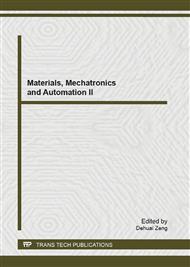[1]
Priestley C H B, Taylor R J. On the assessment of surface heat flux and evaporation using large scale parameters. Mon Weather Rev, 1972, 100(2): 81–92
DOI: 10.1175/1520-0493(1972)100<0081:otaosh>2.3.co;2
Google Scholar
[2]
Pereira A R. The Priestley–Taylor parameter and the decoupling factor for estimating reference evapotranspiration. Agric For Meteorol, 2004, 125: 305–313
DOI: 10.1016/j.agrformet.2004.04.002
Google Scholar
[3]
Sumner D M, Jacobs J M. Utility of Penman–Monteith, Priestley–Taylor, reference evapotranspiration, and pan evaporation methods to estimate pasture evapotranspiration. J Hydrol, 2005, 308: 81–104
DOI: 10.1016/j.jhydrol.2004.10.023
Google Scholar
[4]
Zhang Y Q, Liu C M, Yu Q, Shen Y J, Kendy E, Kondoh A, Tang C Y, Sun H Y. Energy fluxes and the Priestley–Taylor parameter over winter wheat and maize in the North China Plain. Hydrol Process, 2004, 18: 2235–2246
DOI: 10.1002/hyp.5528
Google Scholar
[5]
Mouida A, Alaa N. Identification of Priestley-Taylor transpiration Parameters used in TSEB model by Genetic Algorithm. Int J Computer Science Issues, 2011, 8: 188-197
Google Scholar
[6]
Anderson R G, Jin Y F, Goulden M L. Assessing regional evapotranspiration and water balance across a Mediterranean montane climate gradient Original. Agric For Meteorol, 2012, 166–167: 10-22
DOI: 10.1016/j.agrformet.2012.07.004
Google Scholar
[7]
Smith R C G, Barrs H D, Meyer W S. Evaporation from irrigated wheat estimated using radiative surface temperature. Agric For Meteorol, 1989, 48(3–4): 331-344
DOI: 10.1016/0168-1923(89)90077-4
Google Scholar
[8]
Yao Y J, Qin Q M, Ghulam A, Liu S M, Zhao S H, Xu Z W, Dong H. Simple method to determine the Priestley–Taylor parameter for evapotranspiration estimation using Albedo-VI triangular space from MODIS data. J Appl Remote Sens, 2011, 5(053505):1-16
DOI: 10.1117/1.3557817
Google Scholar
[9]
Shutleworth W J. Evaporation model in hydrology. In: Schmugge T J, Andre J C, eds. Land Surface Evaporation—Measurement and Parameterizaton. New York: Springer-Verlag, 1992. pp.93-120
Google Scholar
[10]
Brutsaert W. Evaporation into the Atmosphere [M]. D. Reidel Publishing Company, Dordrecht, Holland, 1982: 299
Google Scholar
[11]
Flinta A L, Childs S W. Use of the Priestley-Taylor evaporation equation for soil water limited conditions in a small forest clear cut. Agric For Meteorol, 1991, 56(3–4): 247-260
DOI: 10.1016/0168-1923(91)90094-7
Google Scholar
[12]
Baldocchi D D. A comparative study of mass and energy exchange over a closed C3 (wheat) and an open C4 (corn) canopy: I. The partitioning of available energy into latent and sensible heat exchange. Agric For Meteorol, 1994, 67: 191-220
DOI: 10.1016/0168-1923(94)90003-5
Google Scholar
[13]
Guo J.X, Li Q Z, Yan C R, Mei X R, Li Y Z. Effects of small area irrigation on water and heat transport of winter wheat field under drought condition. Trans CSAE, 2008, 24(12): 20-24 (in Chinese with English abstract)
Google Scholar
[14]
Shi C L, Guo J X, Yan C R, Li Y Z, Mei X R. Diurnal variation of instantaneous gas exchange over canopy and leaf level of sp ring corn in arid areas. Trans CSAE, 2007, 23(1): 24-30(in Chinese with English abstract)
Google Scholar
[15]
Allen R G, Pereira L S, Raes D, Smith M. Crop Evapotranspiration. Guidelines for Computing Crop Water Requirements. Irrigation and Drainage Paper No. 56. Rome: FAO, 1998. pp.39-43
Google Scholar
[16]
Fisher J B, Whittaker R J, Malhi Y. ET come home: potential evapotranspiration in geographical ecology. Global Ecol. and Biogeogr, 2011, 20(1):1-18
DOI: 10.1111/j.1466-8238.2010.00578.x
Google Scholar
[17]
Yan H F, Shi H B, Xue Z, Zhang Y Q, Liu H Y. Comparison of estimating ET0 with different methods in Hetao Irrigation District in Inner Mongolia. Trans CSAE, 2008, 24(4): 103-106(in Chinese with English abstract).
Google Scholar
[18]
Wang S G, Kang E S, Jin B W, Wang X P. A Study of estimation of evapotranspiration on grass land in the mountains of Hei River Basin. J Glaciology and Geocryology, 2003, 25(5): 558-565 (in Chinese with English abstract)
Google Scholar
[19]
Zhang Z M. On the calculation of the fluxes of sensible heat and latent heat in the surface layer over saturated underlying surface. Journal of Chengdu University of Science and Technology, 1984, (2) : 89- 96 (in Chinese with English abstract)
Google Scholar
[20]
Li X B, Sun H Y, Zhang X Y, Shen Y J, Dong B D, Hu C S. Analysis of irrigation demands and evapotranspiration in the piedmont of Taihang Mountain. Trans CSAE, 2007, 23(2): 26-30 (in Chinese with English abstract)
Google Scholar


